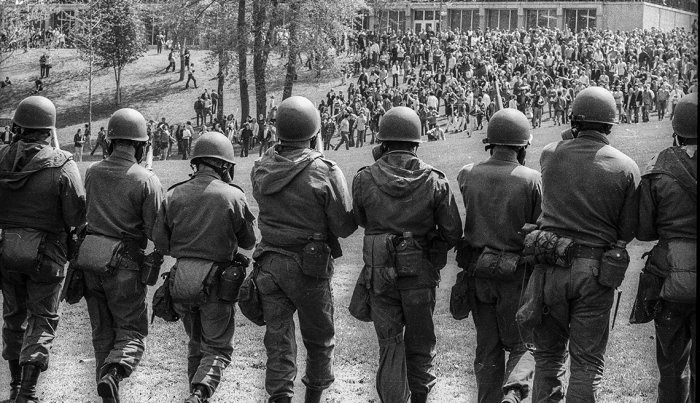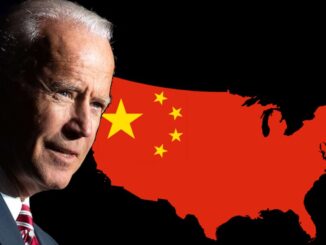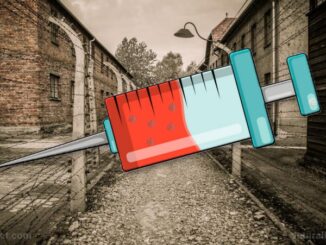
May 4, 1970: Kent State Massacre
On May 4, 1970, in Kent, Ohio, 28 National Guardsmen fire their weapons at a group of anti-war demonstrators on the Kent State University campus, killing four students, wounding eight, and permanently paralyzing another. The tragedy was a watershed moment for a nation divided by the conflict in Vietnam, and further galvanized the anti-war movement.
Two days earlier, on May 2, National Guard troops were called to Kent to suppress students rioting in protest of the Vietnam War and the U.S. invasion of Cambodia. The next day, scattered protests were dispersed by tear gas, and on May 4 class resumed at Kent State University. By noon that day, despite a ban on rallies, some 2,000 people had assembled on the campus. National Guard troops arrived and ordered the crowd to disperse, fired tear gas, and advanced against the students with bayonets fixed on their rifles. Some of the protesters, refusing to yield, responded by throwing rocks and verbally taunting the troops.

Minutes later, without firing a warning shot, the Guardsmen discharged more than 60 rounds toward a group of demonstrators in a nearby parking lot, killing four and wounding nine. The closest casualty was 20 yards away, and the farthest was almost 250 yards away. After a period of disbelief, shock, and attempts at first aid, angry students gathered on a nearby slope and were again ordered to move by the Guardsmen. Faculty members were able to convince the group to disperse, and further bloodshed was prevented.
The shootings led to protests on college campuses across the country. Photographs of the massacre became enduring images of the anti-war movement. In 1974, at the end of a criminal investigation, a federal court dropped all charges levied against eight Ohio National Guardsmen for their role in the Kent State students’ deaths.
Kent State Shootings: A Timeline of the Tragedy
On May 4, 1970, members of the Ohio National Guard trying to disperse a crowd of student demonstrators at Kent State University opened fire, killing four students and wounding nine others.
More than any other single event, the Kent State shootings would become a focal point of the ongoing, bitter divisions among Americans over the Vietnam War. The deadly outburst marked the culmination of several days of confrontations between law enforcement and protesters, which had begun after President Richard M. Nixon announced in a TV broadcast that he had authorized U.S. troops to invade Cambodia.
Nixon’s decision, which expanded the Vietnam War at a time when the United States had been in the process of withdrawing its troops, immediately sparked anti-war protests at colleges across the country—including Kent State.
Nixon’s Invasion of Cambodia Triggers Protests

May 1, 1970
Around noon on the day after Nixon’s speech, some 500 Kent State students and faculty gather on the Commons, a large, grassy area in the middle of campus. They bury a copy of the Constitution to symbolize Nixon’s “murder” of constitutional principles by invading Cambodia without a declaration of war or consultation with Congress. A second rally that afternoon also ends peacefully.
That Friday night, a crowd of drunken protestors form in downtown Kent and begin taunting local police and breaking some store windows. The town’s entire police force mobilizes, forcing the demonstrators back to campus after Kent mayor LeRoy Satrom declares a state of emergency. Things finally quiet down by 2:30 a.m.

National Guard Arrives at Kent State
May 2
Worried about more unrest, Satrom asks the governor, James Rhodes, to mobilize the Ohio National Guard. When Guardsmen begin arriving on the Kent State campus that evening, they find the school’s Army Reserve Officer Training Corps (ROTC) building has been set on fire. A crowd of some 1,000 people surround the building, many of them cheering and confronting firefighters to prevent them from extinguishing the blaze. Using tear gas and bayonets, the National Guardsmen clear the campus by midnight, ordering students into their dorms.

May 3
By Sunday, more than 1,000 National Guardsmen have arrived on campus. Governor Rhodes flies to Kent that morning, and holds a press conference calling the demonstrators “the worst type of people that we harbor in America.” With Rhodes’ support, Kent State administrators announce they are banning a protest rally planned for the next day. Further confrontations between students and Guardsmen break out that night after demonstrators assemble on the Commons near the Victory Bell, which is normally used to celebrate football victories.
Tear Gas, Thrown Rocks, Then Guardsmen Open Fire
May 4
Defying the ban, people begin gathering on the Commons around 11 a.m. By noon, some 3,000 people are there, including a core group of some 500 demonstrators around the Victory Bell, and many more onlookers. The target of their protests shifts from Nixon, Cambodia and the Vietnam War, to the National Guard and its occupation of Kent State.
After the demonstrators refuse to disperse, some 100 of the National Guardsmen begin to march across the Commons. They push the crowd up a slope known as Blanket Hill and down the other side into a parking lot.
Following the crowd into a nearby practice football field, the Guardsmen find themselves blocked in by a fence. They throw tear gas canisters and point their guns at the demonstrators, who yell and throw rocks and other debris at them. After about 10 minutes of this, the Guardsmen begin to move back up Blanket Hill. The crowd cheers their retreat and continues throwing things at them.

At 12:24 p.m., just after reaching the top of the hill, the Guardsmen turn back and fire their M1 rifles and pistols, some of them aiming directly into the crowd. In 13 seconds of shooting, they fire between 61 and 67 shots. Jeffrey Miller, Allison Krause, William Schroeder and Sandra Scheur are killed, and nine other students are injured, including Dean Kahler, who is shot in the back and left permanently paralyzed from the waist down.
In the stunned aftermath of the shootings, Kent State faculty marshals persuade the angry crowd to leave the Commons and avoid further confrontation with the nervous Guardsmen. The administration immediately shuts down the campus, and it remains closed for the rest of the spring semester. Meanwhile, anger over the shootings triggers a nationwide student strike that shuts down hundreds of high schools, colleges and universities.
National Guardsmen Sign Statement of Regret
Even decades later, it remains unclear exactly why the Guardsmen opened fire on the crowd of students at Kent State on May 4, 1970. In subsequent investigations and federal court testimony, many of them testify that they had feared for their lives, and were acting in self defense.
Many people question whether the crowd posed that serious a threat, but criminal and civil trial verdicts accept the Guard’s position. In January 1979, a civil settlement is reached by which the Ohio National Guard pays those injured in the shootings a total of $675,000.
As part of the settlement, 28 Guardsmen sign a statement expressing regret—but not an apology—over how things went down on May 4, 1970.
“Some of the Guardsmen on Blanket Hill, fearful and anxious from prior events, may have believed in their own minds that their lives were in danger,” the statement reads. “Hindsight suggests that another method would have resolved the confrontation.”

H/T History.com
Related: Solzhenitsyn Question: When Should You Resist?
The views, opinions, or positions expressed by the authors and those providing comments are theirs alone, and do not necessarily reflect the views, opinions, positions of Redoubt News. Social Media, including Facebook, has greatly diminished distribution of our content to our readers’ newsfeeds and is instead promoting Main Stream Media sources. This is called ‘Shadow-banning’. Please take a moment and consider sharing this article with your friends and family. Thank you. Please support our coverage of your rights. Donate here: paypal.me/RedoubtNews





